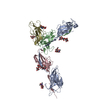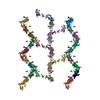[English] 日本語
 Yorodumi
Yorodumi- EMDB-49752: Consensus refinement for the Uromodulin filament lattice interface -
+ Open data
Open data
- Basic information
Basic information
| Entry |  | |||||||||
|---|---|---|---|---|---|---|---|---|---|---|
| Title | Consensus refinement for the Uromodulin filament lattice interface | |||||||||
 Map data Map data | ||||||||||
 Sample Sample |
| |||||||||
 Keywords Keywords | Kidney / urine / uropathogen / filament / lattice / ANTIMICROBIAL PROTEIN / kidney disease / UTI / urinary tract infection / infection | |||||||||
| Biological species |  Homo sapiens (human) Homo sapiens (human) | |||||||||
| Method | single particle reconstruction / cryo EM / Resolution: 4.0 Å | |||||||||
 Authors Authors | Chang AN / Fitzpatrick AWP | |||||||||
| Funding support | 1 items
| |||||||||
 Citation Citation |  Journal: Structure / Year: 2025 Journal: Structure / Year: 2025Title: Structural basis of human uromodulin filament networks in uropathogen capture. Authors: Andrew N Chang / Gabriele Cerutti / Yuki Ogawa / Alia Basler / Willa Switzer / Mia Eng-Kohn / Carolyn Lee / Anthony W P Fitzpatrick /  Abstract: Uromodulin (UMOD), the most abundant protein in human urine, is essential for kidney function and urinary tract health. UMOD forms filaments that bind to uropathogenic bacteria, facilitating their ...Uromodulin (UMOD), the most abundant protein in human urine, is essential for kidney function and urinary tract health. UMOD forms filaments that bind to uropathogenic bacteria, facilitating their aggregation and clearance from the urinary tract. Here, we present the cryo-electron microscopy (cryo-EM) structure of the bacteria-binding D10C domain of UMOD and reveal its binding to the filament core. The details of D10C-core binding explain the formation of distinct filament lattice architectures adopted by UMOD. The D10C-core binding interface gives rise to diverse filament lattice structures, ranging from open and expansive to compact and dense conformations, or a combination of both. We hypothesize that other molecules present in urine may act as cross-linking agents, further stabilizing this binding interface and facilitating the connection of individual filaments into larger networks capable of effectively trapping bacteria. Structural mapping of kidney disease-related mutations points toward the abolition of disulfide bonds and promotion of mutant UMOD aggregation. | |||||||||
| History |
|
- Structure visualization
Structure visualization
| Supplemental images |
|---|
- Downloads & links
Downloads & links
-EMDB archive
| Map data |  emd_49752.map.gz emd_49752.map.gz | 167.9 MB |  EMDB map data format EMDB map data format | |
|---|---|---|---|---|
| Header (meta data) |  emd-49752-v30.xml emd-49752-v30.xml emd-49752.xml emd-49752.xml | 11.7 KB 11.7 KB | Display Display |  EMDB header EMDB header |
| Images |  emd_49752.png emd_49752.png | 47.8 KB | ||
| Filedesc metadata |  emd-49752.cif.gz emd-49752.cif.gz | 3.7 KB | ||
| Others |  emd_49752_half_map_1.map.gz emd_49752_half_map_1.map.gz emd_49752_half_map_2.map.gz emd_49752_half_map_2.map.gz | 165.1 MB 165.1 MB | ||
| Archive directory |  http://ftp.pdbj.org/pub/emdb/structures/EMD-49752 http://ftp.pdbj.org/pub/emdb/structures/EMD-49752 ftp://ftp.pdbj.org/pub/emdb/structures/EMD-49752 ftp://ftp.pdbj.org/pub/emdb/structures/EMD-49752 | HTTPS FTP |
-Validation report
| Summary document |  emd_49752_validation.pdf.gz emd_49752_validation.pdf.gz | 717.1 KB | Display |  EMDB validaton report EMDB validaton report |
|---|---|---|---|---|
| Full document |  emd_49752_full_validation.pdf.gz emd_49752_full_validation.pdf.gz | 716.6 KB | Display | |
| Data in XML |  emd_49752_validation.xml.gz emd_49752_validation.xml.gz | 14.9 KB | Display | |
| Data in CIF |  emd_49752_validation.cif.gz emd_49752_validation.cif.gz | 17.8 KB | Display | |
| Arichive directory |  https://ftp.pdbj.org/pub/emdb/validation_reports/EMD-49752 https://ftp.pdbj.org/pub/emdb/validation_reports/EMD-49752 ftp://ftp.pdbj.org/pub/emdb/validation_reports/EMD-49752 ftp://ftp.pdbj.org/pub/emdb/validation_reports/EMD-49752 | HTTPS FTP |
-Related structure data
- Links
Links
| EMDB pages |  EMDB (EBI/PDBe) / EMDB (EBI/PDBe) /  EMDataResource EMDataResource |
|---|
- Map
Map
| File |  Download / File: emd_49752.map.gz / Format: CCP4 / Size: 178 MB / Type: IMAGE STORED AS FLOATING POINT NUMBER (4 BYTES) Download / File: emd_49752.map.gz / Format: CCP4 / Size: 178 MB / Type: IMAGE STORED AS FLOATING POINT NUMBER (4 BYTES) | ||||||||||||||||||||||||||||||||||||
|---|---|---|---|---|---|---|---|---|---|---|---|---|---|---|---|---|---|---|---|---|---|---|---|---|---|---|---|---|---|---|---|---|---|---|---|---|---|
| Projections & slices | Image control
Images are generated by Spider. | ||||||||||||||||||||||||||||||||||||
| Voxel size | X=Y=Z: 1.074 Å | ||||||||||||||||||||||||||||||||||||
| Density |
| ||||||||||||||||||||||||||||||||||||
| Symmetry | Space group: 1 | ||||||||||||||||||||||||||||||||||||
| Details | EMDB XML:
|
-Supplemental data
-Half map: #1
| File | emd_49752_half_map_1.map | ||||||||||||
|---|---|---|---|---|---|---|---|---|---|---|---|---|---|
| Projections & Slices |
| ||||||||||||
| Density Histograms |
-Half map: #2
| File | emd_49752_half_map_2.map | ||||||||||||
|---|---|---|---|---|---|---|---|---|---|---|---|---|---|
| Projections & Slices |
| ||||||||||||
| Density Histograms |
- Sample components
Sample components
-Entire : Uromodulin filament lattice from human urine
| Entire | Name: Uromodulin filament lattice from human urine |
|---|---|
| Components |
|
-Supramolecule #1: Uromodulin filament lattice from human urine
| Supramolecule | Name: Uromodulin filament lattice from human urine / type: tissue / ID: 1 / Parent: 0 / Macromolecule list: #1 |
|---|---|
| Source (natural) | Organism:  Homo sapiens (human) Homo sapiens (human) |
-Experimental details
-Structure determination
| Method | cryo EM |
|---|---|
 Processing Processing | single particle reconstruction |
| Aggregation state | filament |
- Sample preparation
Sample preparation
| Buffer | pH: 7.4 |
|---|---|
| Vitrification | Cryogen name: ETHANE |
- Electron microscopy
Electron microscopy
| Microscope | TFS KRIOS |
|---|---|
| Image recording | Film or detector model: GATAN K3 BIOQUANTUM (6k x 4k) / Average electron dose: 60.0 e/Å2 |
| Electron beam | Acceleration voltage: 300 kV / Electron source:  FIELD EMISSION GUN FIELD EMISSION GUN |
| Electron optics | Illumination mode: FLOOD BEAM / Imaging mode: BRIGHT FIELD / Nominal defocus max: 2.5 µm / Nominal defocus min: 1.2 µm |
| Experimental equipment |  Model: Titan Krios / Image courtesy: FEI Company |
 Movie
Movie Controller
Controller









 Z (Sec.)
Z (Sec.) Y (Row.)
Y (Row.) X (Col.)
X (Col.)




































